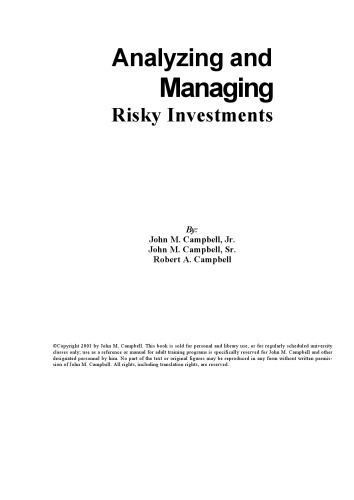Analyzing and Managing Risky Investments 1st Edition by John M Campbell ISBN 0970960700 9780970960702 by John M. Campbell 0970960700 instant download after payment.
Analyzing and Managing Risky Investments 1st Edition by John M Campbell - Ebook PDF Instant Download/Delivery: 0970960700, 9780970960702
Full download Analyzing and Managing Risky Investments 1st Edition after payment

Product details:
ISBN 10: 0970960700
ISBN 13: 9780970960702
Author: John M Campbell
The book "Analyzing and Managing Risky Investments: Risk, Taxes, and Time" Hardcover – 1 April 2001, is authored by John Campbell Sr., Robert Campbell, and John Campbell Jr. and published by CPI.
This textbook, spanning 504 pages, focuses on providing a comprehensive understanding of investment risk, with particular attention to the interplay of risk, taxes, and time in investment decision-making. Published in a large-type hardcover format, it aims to be an accessible and valuable resource for anyone interested in investment management, whether for scholarly or professional purposes.
Given its publication date in the early 2000s, it would have been a timely resource for understanding risk management principles preceding the more complex financial products and crises that emerged later in the decade. It likely covers foundational concepts of risk, quantitative methods for assessment, and practical strategies for managing risk within investment portfolios, with a unique emphasis on how tax implications and time horizons influence these decisions.
Analyzing and Managing Risky Investments 1st Table of contents:
Part 1: Foundations of Investment Risk
- Chapter 1: Introduction to Investment Risk
- What is Investment Risk? Definition and Importance
- Risk vs. Return Trade-off
- Types of Investment Risk (Market Risk, Credit Risk, Liquidity Risk, Operational Risk, etc.)
- The Role of Risk Management in Investment Decisions
- Chapter 2: Basic Statistical Concepts for Risk Analysis
- Measures of Central Tendency (Mean, Median, Mode)
- Measures of Dispersion (Variance, Standard Deviation)
- Covariance and Correlation
- Probability Distributions (Normal Distribution, Skewness, Kurtosis)
- Chapter 3: Understanding Returns and Performance Measurement
- Calculating Investment Returns (Holding Period Return, Annualized Return)
- Risk-Adjusted Performance Measures (Sharpe Ratio, Treynor Ratio, Jensen's Alpha)
- Benchmark Selection and Performance Attribution
Part 2: Identifying and Measuring Investment Risk
- Chapter 4: Market Risk Analysis
- Systematic vs. Unsystematic Risk
- Beta and the Capital Asset Pricing Model (CAPM)
- Factor Models (e.g., Fama-French)
- Historical Volatility and Implied Volatility
- Chapter 5: Value at Risk (VaR) and Expected Shortfall (ES)
- Introduction to VaR: Definition, Calculation Methods (Historical, Parametric, Monte Carlo)
- Strengths and Limitations of VaR
- Conditional VaR (CVaR) / Expected Shortfall as a superior risk measure
- Chapter 6: Credit Risk
- Definition and Types of Credit Risk (Default Risk, Downgrade Risk)
- Credit Ratings and Their Role
- Credit Spreads
- Credit Risk Models (e.g., Merton Model, KMV)
- Chapter 7: Liquidity Risk
- Sources of Liquidity Risk
- Measuring and Managing Liquidity Risk
- Impact on Portfolio Performance
- Chapter 8: Operational Risk
- Definition and Categories of Operational Risk
- Identification, Measurement, and Mitigation of Operational Risk
- Case Studies of Operational Failures
- Chapter 9: Other Key Risks
- Interest Rate Risk
- Currency Risk (Foreign Exchange Risk)
- Inflation Risk
- Political and Regulatory Risk
- Behavioral Risk
Part 3: Portfolio Theory and Diversification
- Chapter 10: Modern Portfolio Theory (MPT)
- Portfolio Expected Return and Risk
- Diversification Principles
- Efficient Frontier and Optimal Portfolios
- Capital Market Line (CML) and Security Market Line (SML)
- Chapter 11: Asset Allocation Strategies
- Strategic vs. Tactical Asset Allocation
- Core-Satellite Approach
- Risk Parity
- Chapter 12: Hedging and Derivatives
- Introduction to Derivatives (Options, Futures, Swaps)
- Using Derivatives for Risk Management (Hedging Strategies)
- Risks Associated with Derivatives
Part 4: Advanced Risk Management Techniques and Applications
- Chapter 13: Stress Testing and Scenario Analysis
- Purpose and Methodology of Stress Testing
- Designing Scenarios (Historical, Hypothetical, Stylized)
- Interpreting Stress Test Results
- Chapter 14: Risk Budgeting and Risk Attribution
- Allocating Risk Capital
- Measuring Contribution to Portfolio Risk
- Linking Risk to Performance
- Chapter 15: Enterprise Risk Management (ERM)
- Integrated Approach to Risk Management
- Risk Culture and Governance
- Implementation of ERM Frameworks
- Chapter 16: Regulatory Aspects of Risk Management
- Basel Accords (Basel I, II, III)
- Solvency II
- Impact of Regulations on Financial Institutions
- Chapter 17: Case Studies and Real-World Applications
- Analyzing Past Financial Crises through a Risk Lens
- Examples of Successful and Unsuccessful Risk Management
People also search for Analyzing and Managing Risky Investments 1st:
managing risky investments
risk management on investment
risk management vs investment banking
managing risk in trading
managing risk in investments
Tags: John M Campbell, Risky, Investments



